Okami Import Hands-On
We sit down with the full Japanese version of this unique-looking game.
We recently imported a copy of Okami, which was released in Japan earlier this week, to see how this unique-looking game turned out for its release overseas. Though Okami seems to be fairly heavy on text, we were able to make our way slowly but surely (with help!) through its many puzzles, using the action adventure and brush mechanics together in effortless harmony to progress through the game.
Okami is Clover Studio's most recent visual smorgasbord (the last being the Viewtiful Joe games), which pits you in the role of Amaterasu, a goddess who has taken on the form of a white wolf to save the world from the darkness that has befallen it. As Amaterasu, you're able to do a number of different things, such as roam around the environment; head-butt objects or smack them with the shield on your back; jump; wall-jump; and most interestingly, impact the environment and creatures around you by switching to a painting mode that lets you draw on the screen with a paintbrush. This is quite fun to execute, although it will be interesting to see how well the puzzles are explained (or how much is left up for you to figure out) once the game is translated to English. As mentioned previously, Okami is laden with text, and it's unclear exactly what's going on during all that exposition. The game's occasional cutscenes and animated characters certainly gave us a good idea of what needed to get done, but we're not yet certain what the lore is behind all of it.
The one aspect of the game that needs no translation is the art style, which is one of the most unique and impressive that we've seen to date. The entire game looks like it's being drawn with a paintbrush while you play it, although at no point does anything seem unclear or unfinished. The environments that you progress through are often blackened or under attack, and as you bound through the scenery, rings of flowers pop up in Amaterasu's wake, symbolizing the good that she is doing to the environment. Of course, simply passing through isn't the way to heal the earth from all of its plagues, so you must engage in a number of different battles and puzzles to help local villagers free themselves and the surrounding nature from the darkness.

Though there's a distinct storyline and main branch of activities, you can engage in a number of side quests. Most of these require speaking with a villager or interacting with the environment, which will give you a brief idea of the problem and how you can solve it. In one section, a merchant is unable to bypass a large boulder blocking his path, so you must find another local man--who will jump onto your back briefly and ride you to the next location--to help you enter painting mode and slice through the rock, freeing up the path for travelers. Not all of what you do seems to be immediately good, however, as we played another minigame that required us to dig up a woman's turnips, all the while dodging her attempts to smack Amaterasu. Digging is another one of his abilities, and though you can dig anywhere, there are select places where you'll uncover hidden treasures, most notably small circles of light that appear throughout all of the levels. Other side quests might involve fighting, such as the ones that require you to cleanse various gates by fighting the enemies that surround them. And the combination of attacking, simple platforming, and brushwork will let you complete all of these tasks simply but in unique and interesting ways.
There are quite a lot of things to pick up in the game, most of which will come from the main quest, though you'll also uncover many in other areas of the maps. The game, although built linearly, does offer a fair amount of open-ended areas to explore, and you can roam around for a bit completing tasks in any order you like until you've finished everything you need to do and can move on. One of the major collection items is the painting scrolls, which teach you new techniques for the painting mode. In one area, we entered a hut and conversed with a character who taught us how to draw a bomb (complete with fuse). This ability in hand, you can go anywhere on the map, press the R1 button--which will tilt the area displayed on the screen down flat and turn it sepia-colored (signifying paper)--and you'll then be able to press the square button and draw free-form anything you wish. Of course, this only has impact on the game if you're drawing the correct object at the correct time, so you'll want to draw the bomb near cracked walls and sections in the floor and not anywhere else.

Another major brush technique is the ability to change the time of day by drawing the sun in the sky, for example. There are two distinctly different times in the game, day and night, although you'll be treated to a few moments of sunset and sunrise in between. Some characters will only interact with you during a specific time of day, so you'll need to force time to pass to speak with these people. During these times (and others), you can paint a circle in the sky to bring the sun out and change night into day.
The game's controls are quite fluid, though not necessarily realistically. For example, Amaterasu jumps much higher than you would expect, but that works only to the game's advantage. She'll also begin to run faster after running for a bit, allowing you to breeze through the few sequences of backtracking effortlessly. It's surprisingly easy to switch between the regular camera mode and the painting mode, which makes it that much more useful when, for example, you knock an enemy over, because you can then switch to painting and slice it in half. The combination of regular gameplay mechanics and the unique painting aspect seems to work very well. Add into the mix the game's authentic soundtrack, Animal Crossing-esque conversations, and charming graphical style, and you have a game that so far looks and plays both very well and unlike anything we've ever seen before. We look forward to hearing more about this game and seeing how the translation fares when it comes stateside later this year.
Got a news tip or want to contact us directly? Email news@gamespot.com
Join the conversation